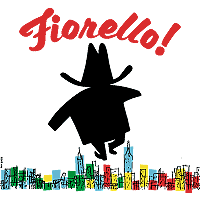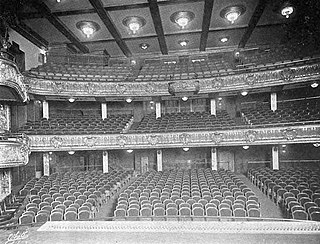
Broadway theatre, or Broadway, is a theatre genre that consists of the theatrical performances presented in 41 professional theaters, each with 500 or more seats, in the Theater District and Lincoln Center along Broadway, in Midtown Manhattan, New York City. Broadway and London's West End together represent the highest commercial level of live theater in the English-speaking world.

The Palace Theatre is a Broadway theater at 1564 Broadway, facing Times Square, in the Midtown Manhattan neighborhood of New York City. Designed by Milwaukee architects Kirchhoff & Rose, the theater was funded by Martin Beck and opened in 1913. From its opening to about 1929, the Palace was considered among vaudeville performers as the flagship venue of Benjamin Franklin Keith and Edward Franklin Albee II's organization. The theater had 1,743 seats across three levels as of 2018.

Wit is a one-act play written by American playwright Margaret Edson, which won the 1999 Pulitzer Prize for Drama. Edson used her work experience in a hospital as part of the inspiration for her play.

Fiorello! is a musical about New York City mayor Fiorello La Guardia, a reform Republican, which debuted on Broadway in 1959, and tells the story of how La Guardia took on the Tammany Hall political machine. The book is by Jerome Weidman and George Abbott, drawn substantially from the 1955 volume Life with Fiorello by Ernest Cuneo, with lyrics by Sheldon Harnick, and music by Jerry Bock. It won the three major theatre awards - Tony Award, the New York Drama Critics Circle award, and the Pulitzer Prize for Drama. It is one of only ten musicals to win the latter award.
Margaret "Maggie" Edson is an American playwright. She is a recipient of the 1999 Pulitzer Prize for Drama for her play Wit. She has been a public school teacher since 1992.

The Knickerbocker Theatre, previously known as Abbey's Theatre and Henry Abbey's Theatre, was a Broadway theatre located at 1396 Broadway in New York City. It operated from 1893 to 1930. In 1906, the theatre introduced the first moving electrical sign on Broadway to advertise its productions.

The Hippodrome Theatre, also called the New York Hippodrome, was a theater located on Sixth Avenue between West 43rd and West 44th Streets in the Theater District of Midtown Manhattan in New York City. The theater operated from 1905 to 1939 and was called the world's largest theater by its builders, with a seating capacity of 5,300 and a stage measuring 100 by 200 feet. It had state-of-the-art theatrical technology, including a rising glass water tank.
The Roundabout Theatre Company is a non-profit theatre company based in Midtown Manhattan, New York City, affiliated with the League of Resident Theatres.
The New Century Theatre was a Broadway theater in the Midtown Manhattan neighborhood of New York City, at 205–207 West 58th Street and 926–932 Seventh Avenue. Opened on October 6, 1921, as Jolson's 59th Street Theatre, the theater was designed by Herbert J. Krapp on the site of the Central Park Riding Academy. It was built for the Shubert brothers, who named the house after Al Jolson.

The Fulton Theatre was a Broadway theatre located at 210 West 46th Street in Manhattan, New York City, that was opened in 1911. It was renamed the Helen Hayes Theatre in 1955. The theatre was demolished in 1982. After the former Little Theatre on 44th Street became the current Helen Hayes Theatre, the Fulton Theatre was sometimes referred to as the First Helen Hayes Theatre.

Paul Kester was an American playwright and novelist. He was the younger brother of journalist Vaughan Kester and a cousin of the literary editor and critic William Dean Howells.

Slava's Snowshow is a stage show created and staged by Russian performance artist Slava Polunin. The show won the Drama Desk Award for Unique Theatrical Experience and was nominated for the Tony Award for Best Special Theatrical Event.
The Garden Theatre was a major theater on Madison Avenue and 27th Street in Manhattan, New York City. The theatre opened on September 27, 1890, and closed in 1925. Part of the second Madison Square Garden complex, the theatre presented Broadway plays for two decades and then, as high-end theatres moved uptown to the Times Square area, became a facility for German and Yiddish theatre, motion pictures, lectures, and meetings of trade and political groups.

The Herald Square Theatre was a Broadway theatre in Manhattan, New York City, built in 1883 and closed in 1914. The site is now a highrise designed by H. Craig Severance.

The Madison Square Theatre was a Broadway theatre in Manhattan, on the south side of 24th Street between Sixth Avenue and Broadway. It was built in 1863, operated as a theater from 1865 to 1909, and demolished in 1909 to make way for an office building. The Madison Square Theatre was the scene of important developments in stage technology, theatre design, and theatrical tour management. For about half its history it had other names including the Fifth Avenue Theatre, Daly's Fifth Avenue Theatre, Hoyt's Madison Square Theatre, and Hoyt's Theatre.

The Broadway Theatre near 41st Street was a Manhattan theatre in operation from 1888 to 1929. It was located at 1445 Broadway.

Olympic Theatre was the name of five former 19th and early 20th-century theatres on Broadway in Manhattan and in Brooklyn, New York.

George M. Cohan's Theatre was a Broadway theatre at Broadway and West 43rd Street in the Midtown Manhattan neighborhood of New York City. It was built in 1911 and demolished in 1938.

The Savoy Theatre was a Broadway theatre at 112 West 34th Street in Midtown Manhattan, New York City. It opened in 1900. It was converted to a cinema around 1910, until it was closed in early 1952 and then demolished.

















